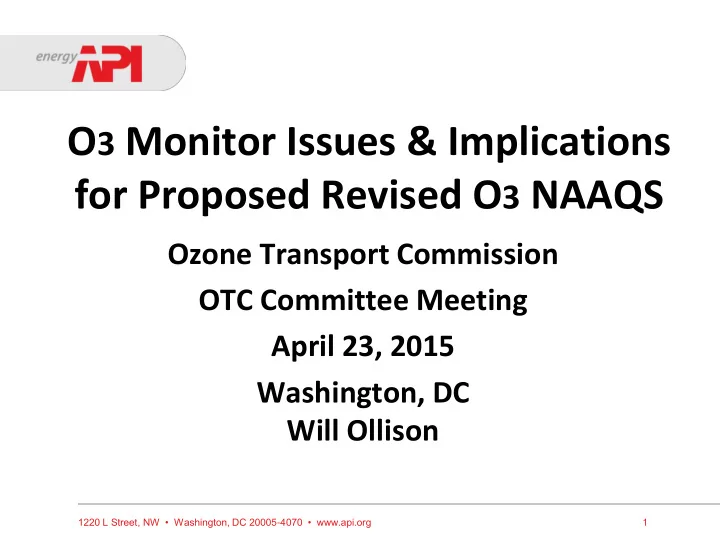

O 3 Monitor Issues & Implications for Proposed Revised O 3 NAAQS Ozone Transport Commission OTC Committee Meeting April 23, 2015 Washington, DC Will Ollison 1220 L Street, NW • Washington, DC 20005 - 4070 • www.api.org 1
O 3 Measurement Developments and Recommendations • A re-measured 254 nm O 3 cross-section, 1.8% lower than now used in NIST standard reference photometers (SRP), increases ambient ozone levels by 1.35 ppb at the 75 ppb NAAQS . This revision also improves SRP agreement with independent non-UV-photometry based methods such as nitric oxide-gas phase titration (NO-GPT). • Given this agreement and SRP’s failure to meet EPA’s proposed UV calibration path length uncertainty specifications ( ≤ 0.5% ) for calibrating FEM/FRM monitors, EPA should develop a new, primary, gravimetric NO standard reference material (SRM)-based GPT ozone reference method. 1220 L Street, NW • Washington, DC 20005 - 4070 • www.api.org 2
A New BIPM 254 nm Ozone Absorption Cross Section? • “If this new value was to be used in SRPs, it would mean an average increase of the measured ozone concentration of 1.8 %. This is consistent with the results obtained for gas phase titration in the international comparison CCQMP28 during which the bias between both methods was observed.” • “The newly reported value should be used in future to obtain the most accurate measurements of ozone concentration, which are in closer agreement with non-UV-photometry based methods such as the gas phase titration of ozone with nitrogen monoxide .” Viallon et al. Atmos Meas Tech 8: 1245-57 (2015) 1220 L Street, NW • Washington, DC 20005 - 4070 • www.api.org 3
SRP Path Length Uncertainty • “It should be noted that quantification of any bias due to divergence of the light beam down the cells was not determined. Although believed to be a small effect, added research is planned to determine the magnitude of this bias. Until this can be quantified, an uncertainty of 0.52 cm has been added to the path-length uncertainty and included in the overall NIST SRP uncertainty budget .” • “A typical set of new absorption cells have an average optical length of 89.660 ± 0.004 cm .” • Percent path length uncertainty = 100 x (0.52/89.66) = 0.58% Norris et al. JAWMA 63: 565-74 (2013) 1220 L Street, NW • Washington, DC 20005 - 4070 • www.api.org 4
EPA-proposed NO-CL O 3 FRM Calibration Specification Appendix D to Part 50 - 4.3.1 UV photometer . “… Because the low- pressure mercury lamp radiates several wavelengths, the photometer must incorporate suitable means to assure that no O 3 is generated in the cell by the lamp and that at least 99.5% of the radiation sensed by the detector is 254 nm radiation. (This can be readily achieved by prudent selection of optical filter and detector response characteristics.) The length of the light path through the absorption cell must be known with an accuracy of at least 99.5% ...” 79 FR 75398 - Proposed revised 40 CFR Part 50, Appendix D, 4.3.1 1220 L Street, NW • Washington, DC 20005 - 4070 • www.api.org 5
Recommendations 1. EPA should revise its proposed NO-CL FRM UV monitor calibration specifications to accommodate current SRP capabilities. 2. EPA should develop a new gravimetric primary O 3 reference standard based on NIST NO/N2 SRMs and GPT, measured by infrared QC laser detection rather than UV photometry. [see Chu et al. IEEE Trans Instrum Meas 56: 305-308 (2007)]. 3. The existing SRPs should be calibrated by the new primary O 3 reference standard and continue in use as a secondary transfer standard network supporting routine field monitor calibrations. 1220 L Street, NW • Washington, DC 20005 - 4070 • www.api.org 6
Recommend
More recommend